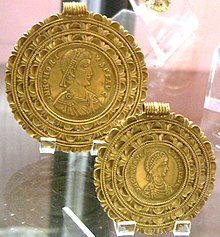Treasure of Velp
The Velp Treasure is an important depository find with gold objects from the early 5th century AD, which was discovered in 1851 near Velp in the municipality of Rheden in the Dutch province of Gelderland . In Velp, a treasure find from the 5th century had come to light elsewhere as early as 1715.
Find from 1715
The find from 1715, a gold neck ring or necklace, arm rings, coins and five medallions, was discovered by chance while working in a pasture. According to the much later publication, however, the necklaces and bracelets lay in a circle in the loose soil, the medallions were attached to the necklaces, the supposedly numerous coins were deposited on top. The bangles and most of the coins were melted down after a short time. The necklace also ended up in the furnace in 1799. Other coins have been published, but no longer detectable today either. They are solidi of Constantine and his sons, Valentinian I , Valens , Gratian , Honorius and Johannes . A multiplum on Honorius and Galla Placidia is incorporated into the medallions . One of the medallions was stolen in Paris in 1831 and is missing. Of the preserved ones, one is in the Cabinet des Médailles of the Bibliothèque Nationale in Paris , the other three in the Rijksmuseum Het Koninklijk Penningkabinet in Leiden . The two Multipla embossed on Galla Placidia were coined between 423 and 426 and offer a term post quem for the concealment of the ensemble. The weight of the found objects is around 250 grams.
Find from 1851
On January 16, 1851, a gardener accidentally found eleven gold objects while digging in Velp. According to research at the time, the site was about 10 minutes away from the site in 1715, so there are two different hoards. According to Janssen's report the following year, the pieces all hung on a large neck ring. There are a total of seven chokers, a gold spiral and a piece of gold wire ( ring gold) as well as two finger rings . This complex weighs a total of 532.63 g, which corresponds to the weight of 117 solidi. The ensemble of finds was sold to Berlin via the art trade as early as 1852 , and neck and finger rings came to the Royal Museums . After the Second World War, the pieces were brought to Moscow by the Red Army and the neck rings were shown publicly again in 2007; the whereabouts of the finger rings were not known at the time.
Six of the neck rings have a widened central part decorated with hallmarks . The rear part is round rod with a pear-shaped locking loop. In one example, the entire middle part bears hallmarks, in the others only the center and - except for one piece - the transitions from the middle to the rear part. Overall, they are so similar to one another that they can be counted as part of a uniform neck ring type Velp. The last neck ring is round rod. The two pieces of ring gold are unusual for the region, comparable finds mostly come from hoards in southern Scandinavia. The two finger rings are Roman products.
The dating of the find from 1851 must be done using comparative pieces. Comparable neck rings appear in the treasure of hatchets , which was hidden around 400 or the early 5th century.
meaning
The treasure find from 1851 contains gold neck rings of the "Velp type", which is only common in the Lower Rhine and Westphalia . It was discussed whether the depots with this type of rings are hidden finds that were hidden during a time of crisis and could not be lifted afterwards, or whether they were intended as offerings. Neck rings could have a symbolic meaning as a badge of rank. The gold neck rings of the Velp type are only found in hoards such as the treasure of hatchets, but not in graves. This could be explained by the fact that the dumping of the gold objects was part of the self-portrayal of the corresponding elites, but they did not dig correspondingly rich man's graves.
literature
- LJF Janssen: Over de gouden collars and rings, te Velp, bij Arnhem, gevonden. Bijdragen voor vaterlandsche Geschiedenis en Oudheidkunde 8, 1852, pp. 161–180. Illustration of the find from 1851
- Wilfried Menghin (Ed.): Merovingian time - Europe without borders. Archeology and history of the 5th to 8th centuries. Exhibition catalog Moscow and St. Petersburg. Berlin 2007.
- Dieter Quast : Velp and related treasure finds of the early 5th century. Acta Praehistorica et Archaeologica 41, 2009, pp. 207-230.
Remarks
- ↑ According to Quast, p. 210, note 11, neither the gold ring nor the finger rings were detectable at the time. It was not possible to determine whether they were still undetected in the Pushkin Museum's storeroom or whether they should be viewed as a war loss.
